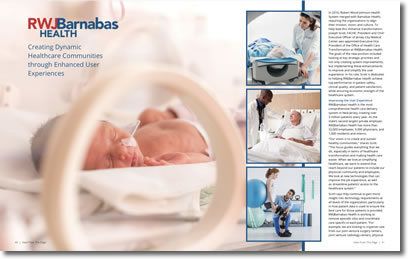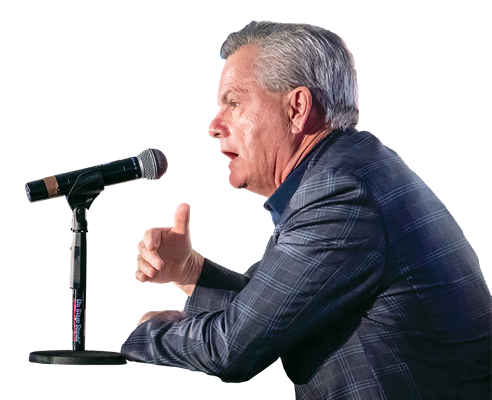In 2016, Robert Wood Johnson Health System merged with Barnabas Health, requiring the organizations to align their mission, vision, and culture. To help lead this immense transformation, Joseph Scott, FACHE, President and Chief Executive Officer of Jersey City Medical Center was appointed Executive Vice President of the Office of Health Care Transformation at RWJBarnabas Health. The goals of the new position included looking at key strategic priorities and not only creating system improvements, but implementing these enhancements to improve and simplify the user experience. In his role, Scott is dedicated to helping RWJBarnabas Health achieve top performance in patient safety, clinical quality, and patient satisfaction, while ensuring economic strength of the healthcare system.
Improving the User Experience
RWJBarnabas Health is the most comprehensive health care delivery system in New Jersey, treating over 3 million patients every year. As the state’s second largest private employer, RWJBarnabas Health has more than 32,000 employees, 9,000 physicians, and 1,000 residents and interns.
“Our vision is to create and sustain healthy communities,” shares Scott. “This focus guides everything that we do, especially in terms of healthcare transformation and making health care easier. When we look at simplifying healthcare, we want to extend that reach beyond our patients to include our physician community and employees. We look at new technologies that can improve the job experience, as well as streamline patients’ access to the healthcare system.”
Scott says they continue to gain more insight into technology requirements at all levels of the organization, particularly in how patient data is used to ensure the best care for those patients is provided. RWJBarnabas Health is working to remove episodic silos and coordinate care specific to each patient. “For example, we are looking to organize care from our joint venture surgery centers, joint venture radiology centers, physical therapy, and home health care, all the way through to our acute care facilities and our post-acute facilities.”
In addition, RWJBarnabas Health is examining the social determinants of health to gain a deeper understanding of each patient and identify the barriers that are preventing them from staying healthy. “Many of us picture food, security, transportation, or housing when we think of social determinants of health,” explains Scott. “While those are important issues, these factors only represent about 20 percent of what is going on with the patient. The other 80 percent involves behavioral changes, for instance, looking for ways to encourage a patient to exercise more regularly. If he or she is overweight and is trending towards diabetes, we determine how to help this person with behavioral changes that will prevent them from becoming diabetic.” Psychosocial support is also essential to improving behavioral health and addressing the potential social determinants of health. “We want to work closely with each patient to better understand how we can intervene and use this insight to coordinate care and address social determinants that lead us to achieving our vision of creating and sustaining healthy communities.”
Transforming Healthcare
The biggest transformation for RWJBarnabas Health is what the organization is calling a “move to value,” which will drive the way patients are treated in the future. “Universally, many healthcare systems today utilize a fee-for-service model,” says Scott. “Healthcare systems are paid every time a patient is seen somewhere within their system. We want to change the focus to the overall health and total cost of care of the patient—improving the health of our communities, reducing the overall cost of care, and improving the quality of care for our patients. This move from a fee-for-service model to a value-based healthcare world will significantly transform the industry going forward.”
As virtual healthcare continues to gain in popularity, more and more healthcare systems are providing these services, causing a groundbreaking shift in doctor-patient interactions. “We have many technology choices coming our way that can improve the healthcare system,” says Scott. “The challenge is picking which options meet the needs of patients going forward, will provide the most insight, and allow us to coordinate care the most effectively.”
RWJBarnabas Health encourages their employees to stay healthy, including an incentive on their healthcare premium if they achieve certain milestones. For instance, points are awarded if an employee gets a biometric screening, sees a primary healthcare physician, or completes a healthcare assessment. “In addition to reduction in premium, we look for ways to help our employees improve their health,” shares Scott. “If we see someone has a rising hemoglobin A1C in his or her biometric screening, for example, that’s a marker for diabetes. Then we can reach out to that employee and help them with dietary changes and exercise. We have health coaches that are dedicated to helping people improve their health and wellbeing.”
Managing Technology
To ensure the user experience continues to advance and improve, RWJBarnabas Health manages a vast range of technology tools across their healthcare systems. “We have a series of task forces that focus on different areas in the organization,” explains Scott. “I head a task force on population policy. The multidisciplinary team includes physicians, nurses, and other administrative personnel who identify any gaps and then determine which technology can help fill those gaps.” Scott says in one example, physician burnout was identified as an issue, resulting from electronic medical records. “We partner with the Newark Venture Partners company called Well Sheet which scrubs the medical record. This technology provides a profile for the physician, so instead of searching through the records for twenty minutes, all the information they need, based upon their preferences, appears when they sign on. If they need to review specific lab work, view medications that have been administered, or see vital signs, the physician determines what they want to see and this saves them significant time searching through the medical record.”
Due to the increasing array and complexity of systems, devices, patients, and provider interactions needed to diagnose, treat, and manage patient care, trying to make sense of the abundance of data points that are generated can be challenging. “One of the things we struggle with today is that we’re on different platforms,” says Scott. “One way that RWJBarnabas Health is addressing this going forward is moving the entire system to a single electronic health record platform. We believe this platform will serve as the longitudinal record, allowing us to take data from disparate sources and inform the medical record. The amount of additional data points that need to be integrated is a huge undertaking but there is definitely progress being made.”
Scott says RWJBarnabas Health focuses on what they believe are the most critical issues for a particular patient, creating a score card that tracks the ongoing progress with a particular issue. “We use an overall balance score to identify the most impactful metrics and then use a systematic process for reviewing those on an ongoing basis. We then provide interventions across our system for improving the outcomes associated with the condition.”
Partnering with Edge
At this year’s EdgeCon, Scott served on a panel that explored Centering the User Experience: Engaging and Serving in the Digital Era. “Among the panel members, there was a universal recognition of how much is happening in the digital age,” shares Scott. “We agreed that a focused approach is necessary to meet the strategic needs of each organization and the key to successfully achieving each individual’s mission.”
In a constantly evolving world of digital transformation, Scott says Edge is vital in helping identify best practices and sharing this knowledge to create a reference point for member organizations. “The shared information provided by Edge gives the important insight organizations need to be successful. Members can see how outcome-based digital transformation impacted others and use their conclusions and resources to improve their own user experiences and guide their organizations toward the future.”




